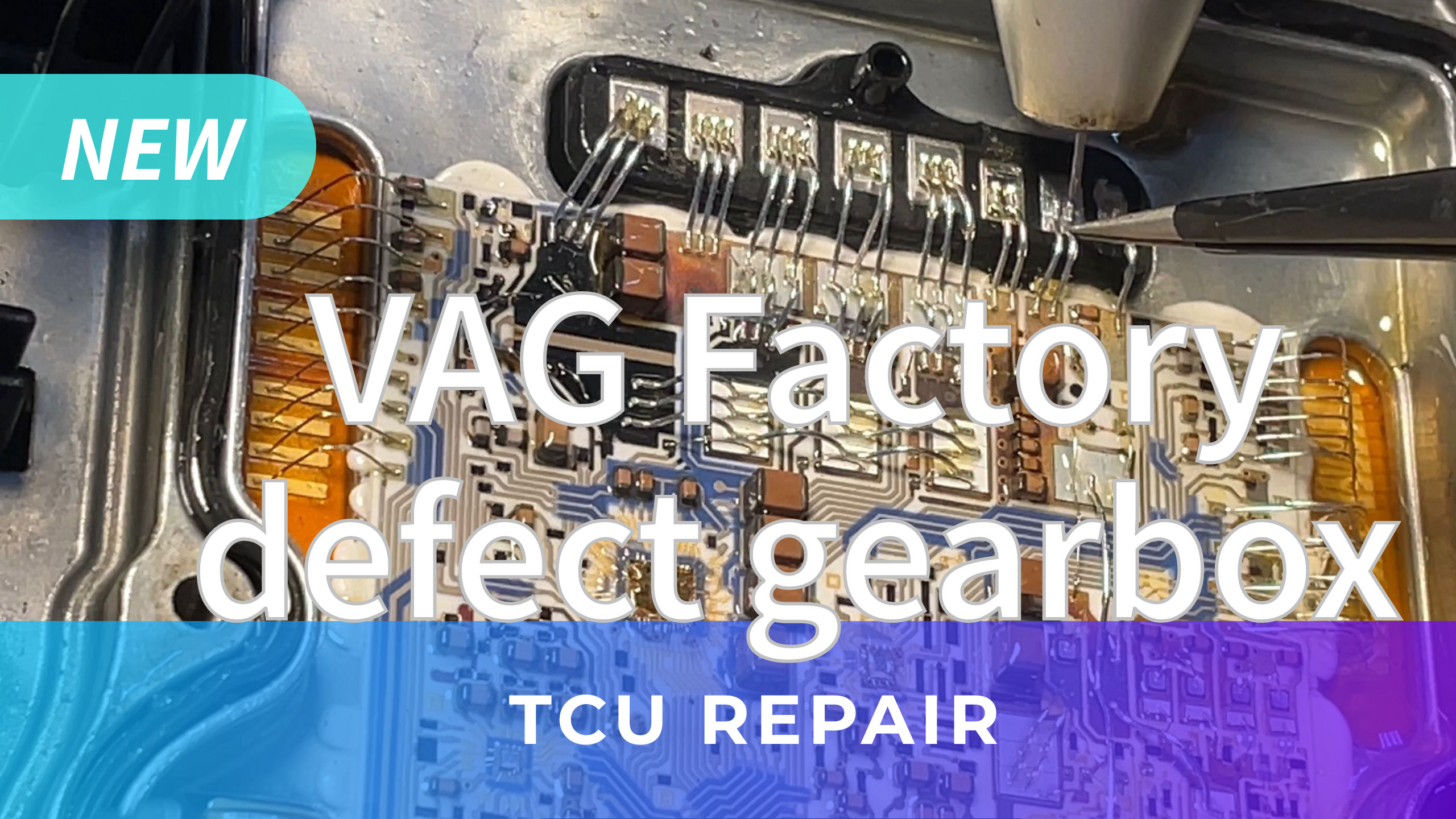
The gearbox that is praised so much in European mithology but behind the curtain is essentially a financial anchor for owners, because at the price of the authorized service, it is almost more expensive than the EV battery, not counting the entire drive motor + gearbox, and if you were to calculate the full price of ENGINE + GEARBOX, it would be over 14,000e. Out of some 500-600 pieces that we repaired, we observed one definite pattern of recurring defects, popularly known as “never nothing fails”. It’s “never nothing” when your non-solderable aluminum wire breaks inside TCU, which was designed to break and costs you 2300 euros, which the owner has no money to pay. Because “electric power” does not go 24,000 km with one reservoir. In addition to broken wires, lines, broken processor TC1796 (label can be seen under a microscope), melting of the power bus voltage supply lines, defect of the three-phase oil pump, output to the valves, valves, hydraulic block, position sensor, fork in the gearbox, gears, clutch also according to mythology homos balkanikus it never breaks down, just because it never breaks down we never laser welded those wires every day, I swear.. never. The error is on all DQ200 series and everything ends very quickly in “never nothing failed” state, some won’t start at 50000km and some won’t start at 150000km. It depends on how much you praise it and how many times a day you change the oil according to ancient mythology. About 10 million vehicles were sold, this news did not end up in the media because the steering wheel did not come off on only one example.
HRVATSKI
Mjenjač koji toliko nahvaljen iza zastora je u biti financijsko sidro, jer je po cijeni ovlaštenog servisa skoro skuplji od baterije EV ne računajuci cijeli pogon motor+mjenjač a kad bi racunali punu cijenu MOTOR + MJENJAC bila bi preko 14000e. Od nekih 500-600 komada koje smo reparirali upratili smo jedan definitivan uzorak ponavljajucih defekata, u narodu poznati kao “nikad ništa”. To nikad ništa je kad ti pukne žičica od aluminija koja se ne lemi, koja je osmisljena da pukne i da vas ona košta 2300 eur, koje vlasnik nema za platiti. Jer “ebeš struju” ne ide na kateter 24000km sa jednim rezervarom. Osim pucanja žica, vodova, pucanja procesora TC1796 (pod mikroskopom se vidi label), topljenja sabirnice napajanja, defekta trofazne uljne pumpe, izlaza na ventile, ventila, hidraulickog bloka, senzora pozicije, vilica u mjenjacu, zubcanika, kuplunga takodjer to se po mitologiji homos balkanikus nikad ne kvari, kak se to nikad ne kvari tako ni mi nikad svaki dan ne varimo laserksi te žice. Greska je na svim serijama DQ200 i sve vrlo brzo završe “nikad ništa”, neke nece na 50000km a neke tek nece na 150000km. Ovisi koliko ga nahvališ i koliko dnevno puta mjenjaš ulje po drevnoj mitologiji. Vozila je zahvećenih oko 10 miliona, ta vijesti nije završila u medijima jer se nije odšarafio volan samo na jednom specimenu. Takodjer valja spomenuti da je ovo proizvod tvornice dječijih bolesti na Dizel Benzin vozilima, zvana Temic. Takodjer ovaj smo napravili sa dodatnim MAX popustom s obzirom da je u pitanju neki penzioner, budu platili hybridaši razliku.
OEM Price for factory defect: 2350eur (incl Tax)
EVC*
-“I swear it never fails” 800euro
-“ICE is swallowing all my money” 300euro
P0562 16946 System voltage, voltage too low
P0841 17225 Sensor / pressure switch transmission fluid pressure A, Unlikely signal
P1604 18012 Control module defective
P177F Hydraulic pump system, supply voltage too low
P17BF Hydraulic pump system, overload protection
P1895 18303 Functional limitation due to pressure drop
P189C Functional limitation due to insufficient pressure
U0101 28773 No communication with TCM
P173A Position sensor 1 for Gear Selector, unlikely signal
P173B Position sensor 2 for Gear Selector, unlikely signal
P173C Position sensor 3 for Gear Selector, unlikely signal
P173D
Partnumbers affect with serial defect:
0AM927769D,
0AM927769K,
0AM927769G,
0AM325025D,
0AM325025H,
0AM325065N,
0AM325025J,
0AM325065L,
0AM325065S,
DQ200 DSG
Cars affected:
Audi A1 2008-2011 1.4l 1.6l 7 Speed
Audi A1 (8X) with 7-speed dual clutch gearbox Model Years 2011-2016
Audi A3 (8P, 8V) with 7-speed dual clutch gearbox Model Years 2008-2016
Audi Q3 2011 1.4l 1.6l 1.8l 7 speed
Audi TT (8J) with 7-speed dual clutch gearbox Model Years 2012-2016
SEAT Altea / XL 2009-2011 1.6l 1.8l 7 speed
SEAT Ibiza 2009-2011 1.2l 1.4l 1.6l 7 speed
SEAT Leon 2007-2011 1.8l 7 speed
Skoda Fabia 2010- 2011 2013-2015 7 speed
Skoda Modela 2011 1.4l 1.6l 7 speed
Skoda Octavia Model Years 2009-2015 7 speed
Skoda Superb Model Years 2008-2015 7 speed
Skoda Rapid Model Years 2014-2015 7 speed
Skoda Roomster Model Years 2013-2014 7 speed
Skoda Yeti Model Years 2013-2015 7 speed
Volkswagen Beetle / convertible Model Years 2011-2015 7 speed
Volkswagen Bora 2010-2011 1.4l 1.6l 7 speed
Volkswagen Caddy Model Years 2010-2015 7 speed
Volkswagen Golf / Golf Plus Model Years 2007-2015 7 speed
Volkswagen Jetta / Jetta Wagon Model Years 2008-2015 7 speed
Volkswagen Lavida 2010-2011 1.4l 1.6l 7 speed
Volkswagen Passat Model Years 2008-2015 7 speed
Volkswagen Polo Model Years 2007-2015 7 speed
Volkswagen Sagitar 2009-2011 1.4l 7 speed
Volkswagen Scirocco 2008-2011 1.4l 7 speed
Volkswagen Sharan 2010-2011 1.4l 7 speed
Volkswagen Tiguan 2011 1.8l 7 speed
Volkswagen Touran 2010-2011 1.4l 1.6l 1.8l 7 speed
And other models with a DSG 7 speed gearbox


















